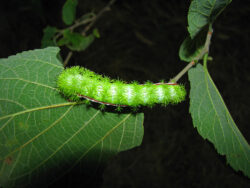When you think of dangerous pests, caterpillars most likely are one of the last ones to come to mind. In Florida, there are a few species of caterpillars that can sting, causing a range of reactions from minor itching and burning to full fledged allergic reactions. These stinging caterpillars are prevalent in Florida because of its climate; the longer warm season allows more time to reproduce, with 3 to 4 generations per year (versus 1 to 2 generations in colder climates).
Some of the most common stinging caterpillars found in Florida include the IO moth caterpillar, the puss caterpillar, the saddleback caterpillar, and the hag moth caterpillar.
IO Moth Caterpillar
These caterpillars are easy to spot, with pale green bodies and yellow and red stripes. Their spines are yellow with black tips, attached to poison glands. They can grow to more than 2 inches in length. They are known to feed on more than 100 species of plants, including oak, azalea, rose, corn, and hibiscus.
Puss Caterpillar
These caterpillars have a convex body shape that is covered with gray to brown hairs. Spines are attached to poison glands underneath these hairs. When touched, the spines break off into the skin causing severe pain. They grow to be about an inch in length and are commonly found on oak and citrus.
Saddleback Caterpillar
These caterpillars are very distinctive in appearance with brown bodies and bright green middles (that resemble a saddle blanket), along with a purple to brown oval-shaped spot (that resembles a saddle) in the center of their backs. They have stinging hairs on the front and rear of their bodies and grow up to 1 inch in length. They feed on ornamental plants such as oak, rose, corn, pear, and plum.
Hag Moth Caterpillar
These caterpillars are less common than the others. They are light to dark brown in color with hairy arms that curve and twist with stingers. They grow to about 5/8″. They are commonly found on landscape trees and shrubs like ash, dogwood, oak, and rose.
To avoid caterpillar stings, always look before reaching into plants. It is also beneficial to familiarize yourself with the most common of these pests found in your area to make them easier to identify if you encounter them. If you do come across one, wear thick gloves to remove them and either squish them or drop them into a container of rubbing alcohol. If stung, use adhesive tape to remove the spines from your skin and apply ice to help with the stinging and pain. You can also apply a paste of baking soda and water to also help with the sting.
If you have a problem with caterpillars or any other pests, contact your local pest control company for assistance.



